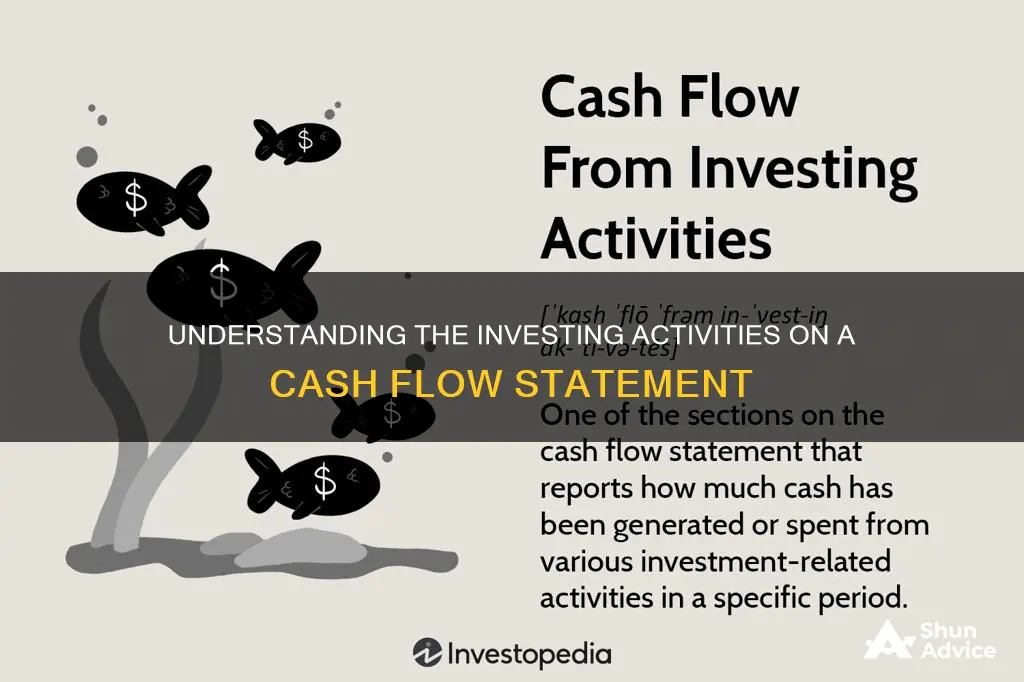
Investing activities are a critical component of a company's cash flow statement, reflecting significant capital movements and providing a window into the company's investment strategies and financial standing. This section of the cash flow statement details the cash inflows and outflows resulting from investment activities, such as the acquisition and disposal of long-term assets, investments in securities, and acquisitions of other businesses. It is important for stakeholders, including investors and financial professionals, to understand these trends when assessing a company's future prospects and financial health.
| Characteristics | Values |
|---|---|
| Definition | Cash Flow from Investing Activities (CFI) is a section of a company's cash flow statement that reports the cash inflows and outflows resulting from investment activities. |
| Purpose | To reveal a company's investment performance and capital allocation decisions. |
| Types of Activities | Acquisition and disposal of long-term assets, investing in securities, and acquiring other companies. |
| Types of Transactions | Cash spent on or received from buying and selling assets, money from investments in other companies and securities, loans made to third parties, and the collection of loans made by the entity. |
| Calculation | Subtract total cash outflows from total inflows related to investing activities to find the net cash flow. |
| Importance | Provides insights into a company's capital expenditure, investment strategies, and financial health. |
| Positive Cash Flow | Indicates effective management of investments, strategic acquisitions, and potential for future growth. |
| Negative Cash Flow | May signal expansion efforts and future gains, but could also indicate caution or low profitability. |
| Examples | Apple Inc., Amazon, and Hershey's financial statements provide real-world examples of CFI calculations. |
| Connection to Other Statements | CFI is linked to the balance sheet and income statement, providing a comprehensive view of a company's finances, including assets, liabilities, earnings, and cash position. |
| Limitations | Negative cash flow is not always a negative indicator, as it may reflect strategic investments in future growth. |
What You'll Learn
- Cash flow from investing activities can include the purchase or sale of physical assets
- It can also include investments in securities
- It may also cover the acquisition of other businesses
- Cash flow from investing activities can be impacted by proceeds from the sale of other businesses
- Finally, it can include purchases or sales of marketable securities

Cash flow from investing activities can include the purchase or sale of physical assets
Cash flow from investing activities (CFI) is a critical component of a company's cash flow statement. It offers valuable insights into the company's investment performance, capital allocation decisions, and overall financial health. This section of the cash flow statement details the cash inflows and outflows generated from various investment-related activities over a specific period.
One significant aspect of cash flow from investing activities is the purchase or sale of physical assets. This includes long-term assets such as property, plant, and equipment (PPE). When a company invests in acquiring physical assets, it results in a cash outflow, generating negative cash flow in the short term. However, these investments are crucial for the company's long-term growth and capital improvement. For example, investing in new machinery or real estate can enhance operational efficiency and expand the company's capabilities.
On the other hand, the sale of physical assets, such as old equipment or unused real estate, leads to a cash inflow, resulting in positive cash flow. This positive cash flow can be utilised for various purposes, including paying off debts, covering operating costs, or reinvesting in the business. It demonstrates the company's ability to effectively manage and liquidate its assets when needed.
The purchase and sale of physical assets play a vital role in a company's growth strategy and financial planning. Negative cash flow from investing activities doesn't always indicate poor financial health. Instead, it may signal that the company is making strategic investments in its future growth and competitiveness. By analysing the cash flow statement, investors and financial professionals can gain insights into the company's investment strategies and make informed decisions about its future prospects.
Overall, the cash flow from investing activities, including the purchase and sale of physical assets, provides a comprehensive view of a company's financial health, investment performance, and growth initiatives. It is an essential tool for stakeholders to assess the company's allocation of resources and its potential for long-term success.
Cash App Investment Options: Where to Put Your Money
You may want to see also

It can also include investments in securities
Investment securities are a category of securities—tradable financial assets such as stocks, bonds, or derivatives—that are purchased with the intention of holding them for investment. They are often held by banks as collateral, taking the form of equity (ownership stakes) in corporations or debt securities.
Investment securities can be further broken down into two types: equity and debt. Equity securities provide ownership rights to shareholders, allowing them to profit from capital gains when they sell the securities, assuming they have increased in value. Debt securities, on the other hand, represent borrowed money that must be repaid with interest. Examples include government and corporate bonds, certificates of deposit, and collateralized securities.
When it comes to investing activities on a statement of cash flows, investments in securities are a crucial component. This includes the purchase or sale of securities, which can have a significant impact on a company's cash position and financial health. A positive cash flow from investing activities indicates that a company is generating more cash from its investing activities than it is spending, which can be a sign of effective investment management. Conversely, negative cash flow from investing activities can signal that a company is investing in future gains, such as through research and development or long-term assets.
Overall, the inclusion of investments in securities within investing activities on a statement of cash flows provides valuable insights into a company's financial health, investment strategies, and future prospects. It is an important aspect of financial reporting and analysis.
Understanding Cash Flow: Investing Activities Explained
You may want to see also

It may also cover the acquisition of other businesses
Investing activities are a critical component of a company's cash flow statement, reflecting significant capital movements. These activities include the acquisition and disposal of long-term assets, such as property, plant, and equipment (PPE), as well as investments in marketable securities and other companies.
The acquisition of other businesses falls under investing activities in a company's cash flow statement. This involves purchasing another company or business unit, which is considered a cash outflow from investing activities. This type of transaction is often a significant outlay aimed at strategic growth and can include mergers and acquisitions.
When a company acquires another business, it is investing in future growth and expansion. This type of investment can lead to greater strength and prosperity in the long term. It indicates that the company is making strategic moves to grow and win in the market, and it reflects the company's commitment to expanding its operations and entering new markets.
The acquisition of other businesses is a crucial aspect of a company's growth strategy. It showcases the company's vision for boosting its assets and market position. By analysing the cash flow statement, investors and analysts can gain insights into the company's asset management and spending on big purchases. This helps in understanding the company's growth story and its financial health.
It is important to note that a negative cash flow from investing activities is not always a negative sign. It could indicate that the company is making strategic investments in its future, which may lead to greater financial gains in the long term.
Invest Cash Safely: Strategies for Secure Financial Growth
You may want to see also

Cash flow from investing activities can be impacted by proceeds from the sale of other businesses
Cash flow from investing activities is a critical component of a company's cash flow statement, often reflecting significant capital movements. It includes the purchase or sale of non-current assets, such as property, plant, and equipment (PPE), marketable securities, and investments in other companies. These activities can have a substantial impact on a company's cash position and are crucial for understanding its financial health and future prospects.
Proceeds from the sale of other businesses can indeed impact cash flow from investing activities. When a company sells a business unit or subsidiary, it can result in a cash inflow that is classified as an investing activity. This is considered a divestiture, and the cash received from the sale will positively impact the cash flow from investing activities.
The impact on cash flow will depend on the sale price and the original cost of the business. If the sale price is higher than the original cost, the company will realise a gain, and the cash inflow will be greater than the initial investment. Conversely, if the sale price is lower than the original cost, the company will incur a loss, and the cash inflow will be lower. However, any cash received will still positively impact the cash flow from investing activities, even if the sale was made at a loss.
For example, consider a company that purchased a subsidiary for $100 million and later sold it for $150 million. The $150 million received from the sale would be recorded as a cash inflow in the investing activities section of the cash flow statement. This would positively impact the cash flow from investing activities, indicating a gain from the sale.
On the other hand, if the company sold the subsidiary for $80 million, it would still record the $80 million as a cash inflow in the investing activities section. However, the sale price is lower than the original cost, resulting in a loss of $20 million. Even though the company incurred a loss, the cash flow from investing activities would still be positive due to the cash inflow from the sale.
The impact of proceeds from the sale of other businesses on cash flow from investing activities is essential for stakeholders, including investors and financial professionals, to assess the company's financial health and future prospects. It provides insights into the company's investment strategies and its ability to generate cash from its investments. A positive cash flow from investing activities can indicate effective management of investments and strategic planning for future growth.
CDs: Cash or Investment?
You may want to see also

Finally, it can include purchases or sales of marketable securities
Purchases or Sales of Marketable Securities
Marketable securities are financial assets that can be sold or converted to cash within a year. They are typically bought or sold on an exchange and include stocks, bonds, certificates of deposit, or commodities contracts. Companies can add to their bottom line by purchasing or selling these marketable securities.
Marketable securities are a component of current assets on a firm's balance sheet. They are part of a figure that helps determine a company's liquidity, its ability to pay expenses, and its ability to pay down debt if it needs to liquidate assets into cash to do so.
Marketable securities are designated as current assets because they are intended to be held for less than a year. However, some companies will list them as non-current assets if they intend to hold them for longer. An example would be a company planning to acquire a target firm by purchasing and holding its shares.
The cash flow statement would show the changes in the fair market value of the investments as a reconciling item in the operating section of the statement. The investing section of the statement always shows the cash used to purchase securities or the cash received from the sale of securities. For example, when marketable securities are sold at a gain, the cash inflow from the sale would be denoted on the cash flow statement.
Examples of Marketable Securities in Cash Flow Statements
- Apple Inc. (AAPL): Apple reported purchases of marketable securities for $29.52 billion and proceeds from the sale of marketable securities for $5.83 billion in its statement of cash flows for the twelve months ending September 30, 2023.
- Hershey Company: In 2023, Hershey made significant investments in capital expenditures, including equity investments in tax credit-qualifying partnerships. Their net cash flow from investing activities was -$1,198,676 thousand.
Extra Cash: Where to Invest for Maximum Returns
You may want to see also
Frequently asked questions
A statement of cash flows is a financial statement that tracks the inflow and outflow of cash to provide insights into a company's financial health and operational efficiency. It is one of the three main financial statements, alongside the balance sheet and the income statement.
Investing activities include purchases of long-term assets (such as property, plant, and equipment), acquisitions of other businesses, and investments in marketable securities (e.g. stocks and bonds).
Investing activities are important because they reflect a company's strategy towards long-term assets and growth initiatives. They can indicate how much a company is looking to grow and develop in the future, and provide insights into its financial health.







